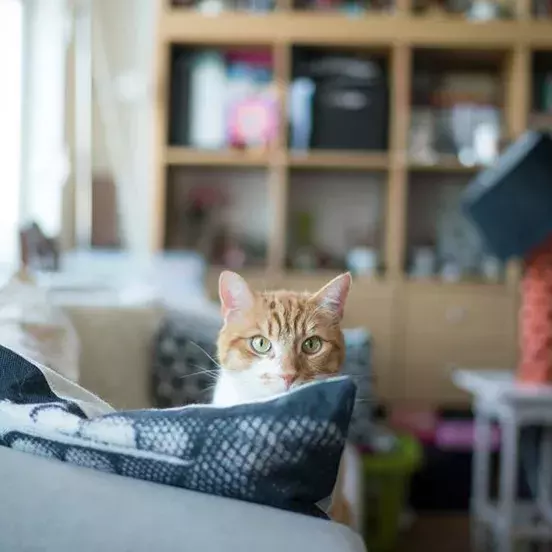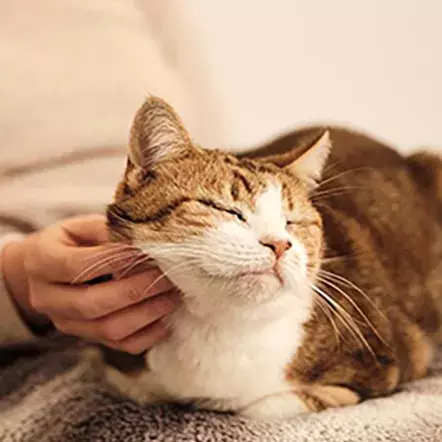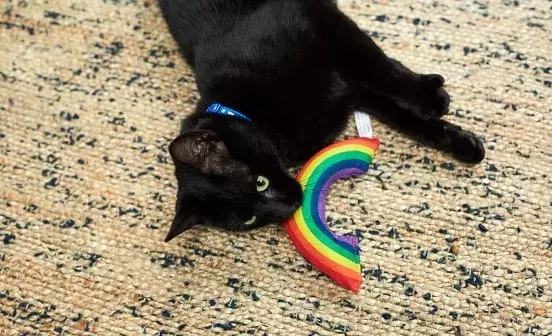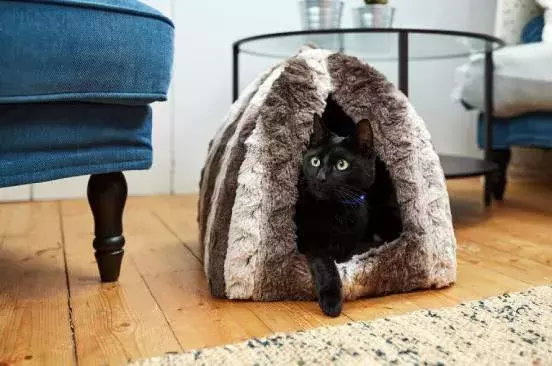Cats experience fear and anxiety in a very similar way to humans and will do whatever they can to protect themselves. It is important to be able to recognise signs of anxiety in your cat and how to respond in these situations.
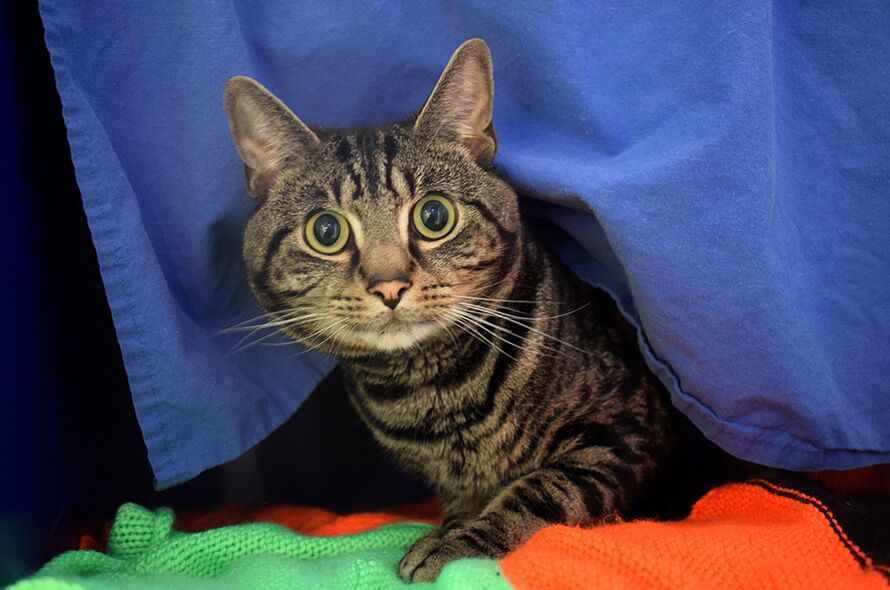
Cats may become anxious about possible threats but will experience fear when they think they are in immediate danger. For example, your cat might get anxious when you bring out the cat carrier that only appears immediately before a vet visit but will become scared when approached by an unfamiliar dog.
Whether the cat is actually in danger or not (from our perspective) makes little difference to how the cat will experience a situation – what matters most is that to the cat, the threat seems real.
Take a look at our video on understanding cat body language.
HOW DO I TELL IF MY CAT IS ANXIOUS OR SCARED?
If your cat is anxious or scared, they are likely to use these basic strategies to help protect themselves:
FLIGHT
If your cat is confronted with something they find frightening, their first instinct will most likely be to remove themselves from the situation. Your cat may either turn and run or move very cautiously while keeping their eye on the potential ‘threat’. In both cases, your cat will seek out the nearest point of safety, usually either a hiding place or somewhere up high.
FIGHT
In general, if your cat is already fearful or anxious, they are only likely to behave aggressively if their preferred option (flight) is not available; for example, your cat may feel ‘trapped’ or that they have limited options in terms of retreating to safety. Alternatively, your cat may have previously learnt that a pre-emptive ‘attack’ is the best way to protect themselves. In both cases your cat may just growl and hiss but could also swipe or bite.
FREEZE
As an alternative to ‘fight’ and ‘flight’, your cat may freeze when they are either startled by something, or when they do not have the option to retreat to safety. Your cat may also use this strategy to ‘buy time’ whilst your cat decides what the best course of action to take next is (for example should they attempt to escape or ‘attack’?).
FIDGET
This is another alternative to ‘fight’ and ‘flight’. Your cat may start to fidget by suddenly beginning to groom themselves or appearing to become very interested in something nearby, perhaps going off to sniff or investigate it. This may help to calm themselves a little but will also reduce or diffuse ‘tension’ in a situation where the cat experiences conflict or is uncertain about what to do next. As with a ‘freeze’ your cat may also use this strategy to ‘buy time’ before deciding what to do next. A cat may be most likely to fidget when experiencing anxiety.
OTHER BEHAVIOUR SIGNS OF A STRESSED CAT
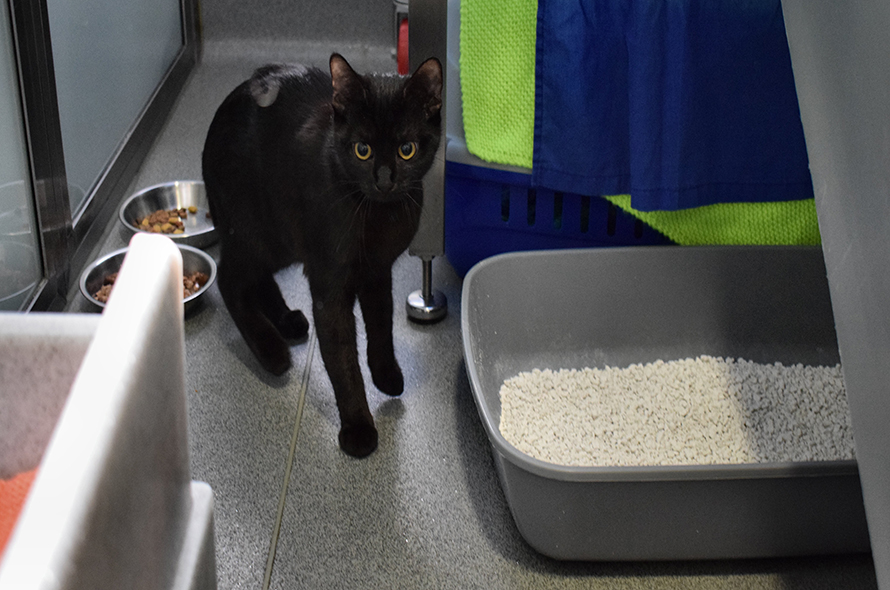
- In situations of intense fear, your cat will be in an acute state of stress. Your cat may breathe very rapidly and appear to tremble or shake. Your cat may also involuntarily go to the toilet.
- Your cat will be very vigilant, responsive or ‘jumpy’ and is likely to be intensely focused on the thing that they are fearful of.
- Piloerection may also occur, this is where the fur on their back and tail appears puffed up, they may also try to look as big as possible by raising their tail, arching their back and standing up tall.
- If your cat moves when in the above position, they will likely move away slowly, at an angle, keeping their body and head facing towards the perceived ‘threat’. This may look like your cat is performing a ‘moon walk’ of sorts, but they are trying to remain as big as possible, whilst also keeping an eye on the ‘threat’. In the outside world, turning and running away quickly may also trigger a chase response in a potential predator, therefore your cat may be cautious about using this strategy too quickly.
BEHAVIOUR SIGNS OF CAT ANXIETY
- If your cat is anxious for a period of time, they may experience chronic stress. You may notice that your cat changes their usual routine in some way (usually to avoid situations that may increase their anxiety levels). Your cat may start to avoid certain areas of the home at particular times of day or avoid them all together.
- Your cat may start to only use their litter tray, food, water, beds etc. at quieter times of day, for example, overnight or when people are out at work.
- Your cat may either start to over groom (sometimes leading to bald patches on their coat) or stop grooming as much (sometimes leading to a poor, dull looking or tangled coat with visible dandruff).
- Your cat may become less keen to interact with people and appear to hide and sleep more.
- Your cat may eat, play and explore less, appearing quieter and more introverted.
BODY LANGUAGE OF AN ANXIOUS CAT
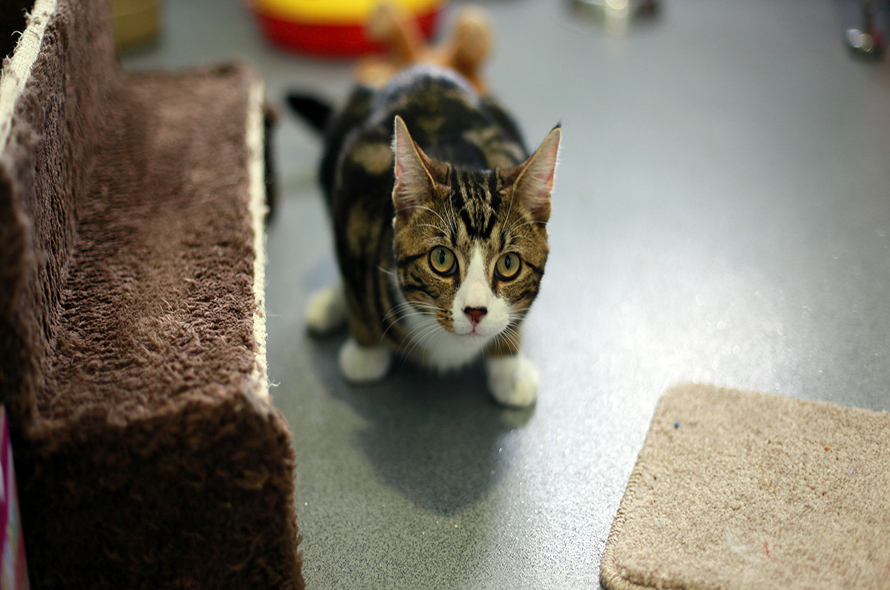
- If your cat is hiding, or alternatively if your cat has ‘frozen’ in fear, they are likely to have a tense, hunched or crouched posture, usually pressed quite low to the ground.
- Your cat will have all four of their feet planted firmly underneath themselves so that they are ready to quickly escape or take a defensive swipe with a paw if the situation escalates.
- Your cat’s legs and tail are likely to be pressed close to the rest of their body, their head lowered, and neck pulled in towards their shoulders.
FACIAL EXPRESSIONS OF AN ANXIOUS CAT
- Your anxious cat is likely to have very wide, rounded eyes and very dilated pupils.
- Your cat’s ears will be flattened down to the sides, or in extreme situations, pressed back against their head so that they are no longer visible.
- Your cat may briefly lick their nose (also called a ‘lip lick’), possibly repeating this several times.
WHAT SHOULD I DO IF I SUSPECT MY CAT HAS ANXIETY?
If you notice your cat displaying any of the anxious behaviours or body language, it’s important to understand why. This way you can try to avoid exposing your cat to situations where they are likely to experience fear or anxiety, or at least try to help them feel more safe and secure. For example:
- Provide your cat with lots of quiet hiding spaces and places where they can get up high, in a predictable and relatively quiet home environment. This will help your cat feel more secure. For more advice on managing your cat’s stress and anxiety see our advice on reducing stress.
- If your cat is fearful of the vacuum cleaner, make sure to only vacuum rooms when your cat is not in them. You could also try to vacuum on predictable days or at predictable times so that your cat can anticipate when this happens and avoid those areas ahead of time.
- If your cat is particularly anxious or fearful when interacting with young children, see our advice on encouraging safe and positive relationships between cats and children.
- If your cat’s anxiety or fear is caused by other cats, either within the household or outside, take a look at our advice on: Introducing your new cat to your resident cat and How do I stop my cat fighting.
If your cat’s anxiety or fear is caused by a dog that your cat shares the house with, see at our advice on Introducing cats and dogs. - If there are no obvious reasons you can identify that could be causing your cat to feel anxious it’s a good idea for you to seek help from a cat behaviour counsellor. If you have rehomed a cat from Battersea, you can also contact the Battersea Cattery Team for further support.
